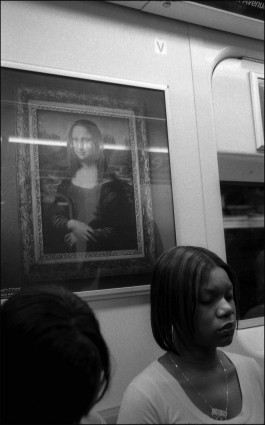2015: a good year in photography!
2015 was a good year in photography for me. I was lucky and honored to participate in several exhibits, a portfolio of my “Subway Pictures” was published in Black & White magazine, one of my photos won a prize in the “Maine Photo Show” and my work was part of several reviews by Daniel Kany in the Audience Section of the Maine Sunday Telegram. (March 15th, the 3Fish Exhibit, and October 4th (The 3 City exhibit at UNE). I was happy about the reviews, ( in one review Kany referred to my photographs as “Gritty” , in the other one he called one of my photographs “Gorgeous”) I found the way he described my work pretty satisfying. It is not Kany’s job to make me feel satisfied about my work but if it does, I don’t object. In both reviews he brought up the matter of “photographing people without their consent” which is a perfectly legitimate subject to bring up, certainly as it pertains to my work. In one of the reviews, while commenting on one of the photographs of a sex worker in Amsterdam, he observed that the window in which the subject was situated had a “No Photography” sign in it. So why did I take the photograph? In the Three City show he refers to my “Covert” subway shot of a tough guy in a white shirt. He finds the photograph “Gorgeous” but with an “odd punctuation” about questionable permission. Let me first say that I think bringing up the question of permission in documentary or street photography is timely especially in these times where the privacy versus safety issues are the talk of the day. So the subject is close to my heart because when doing such work I find myself often in situations where getting permission for certain shots is impossible, mostly because if the subject is being made aware, the photograph would cease to exist. Documentary and street photographers photograph the world around them. They photograph the human condition and human behavior. In most instances when a spontaneous opportunity for such a photograph occurs the subject of such a photograph would ideally be unaware that a picture is being taken. If there were awareness people would “act” and not behave naturally. We usually photograph in the public domain, (and if not, permission should be granted) and (especially) these days, one could hardly expect privacy while spending time in public places. We live in a society of rules and, while in public, as members of this society, there is an expectation that we behave according to these rules. If we deviate from these rules it is done at our own risk. So if one gets photographed while misbehaving in public, I’d say that would be too bad. Besides, today we get photographed more often than we realize. There are security cameras every where. Legally there is no problem taking photographs in public places in most countries, although the rules may vary somewhat from country to country. There are pretty clear rules about how to use these photographs. (Commercial use, editorial use etc.) Historically the “photograph taken in public” without permission has been an important part of the medium. We can go back to the 1938 “Subway Portraits” by Walker Evans. He covered up his camera with a cardboard box while taking his famous subway portraits. It does not seem that Bruce Davidson asked for permission for his 1980 “Subway, N.Y.C.” shot. Helen Levitt photographed street children “without being seen by them”, and had a major exhibit of these photographs at the Museum of Modern Art in 1943. Both Robert Frank and William Klein often photographed their subjects without even looking though the view finder!
In war photography it does not seem likely that Robert Capa got permission from the “Republican Soldier” before he was shot dead during the Spanish Civil War or for that matter from the soldiers dying at Omaha Beach. Other examples of photographers not asking permission from their subjects are Garry Winogrant, Joel Meyerowitz, Friedlander, Arbus, Cartier Bresson and Salgado. There are too many other examples to mention. I agree that we photographers have a duty to portray our subjects with honesty, that we don’t misrepresent them or make them look or appear anything else than what they are. To intrude into a private space and photograph people in that privacy without permission should be and is illegal and is at least unethical. If we want to portray and lay witness to the world around us we should do so with integrity and honesty.


Comments are closed.